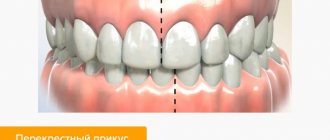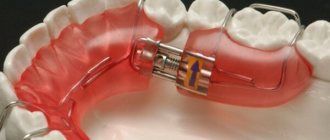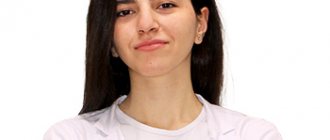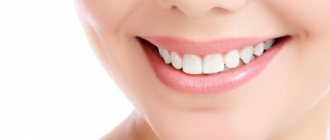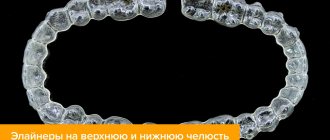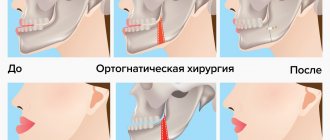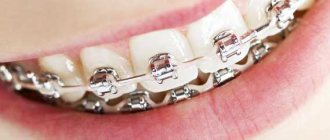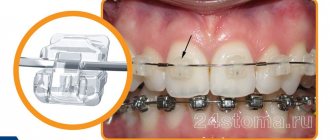When does a child need to have their bite corrected?
Parents should note all important details in the child’s unconscious behavior. Pay attention to how the child breathes, whether his mouth is often open, whether he snores in his sleep, what position the lower jaw is in, whether he likes to gnaw hard objects - these factors have a huge impact on the development of dental pathologies. Take a closer look at the posture and structure of the foot, these are also important indicators of possible violations. Did you find any deviations? Consult a professional.
Risk factors
- difficulties with nasal breathing, for example, due to adenoids or allergies;
- spinal column deformity;
- bad habits;
- genetic predisposition to dental anomalies;
- diseases of the central nervous system.
If the listed risk factors are present, treatment will be effective only with the participation of doctors from related fields. Therefore, it is best to contact myofunctional centers, which unite orthopedists, pediatric dentists, orthodontists and osteopaths. The joint work of specialists guarantees accurate diagnosis and successful resolution of the issue.
Age for correcting malocclusion in children
You should think about visiting an orthodontist after teething. If necessary, the specialist will prescribe a comprehensive examination and radiography to identify the causes of dental anomalies. Then you should get advice from doctors in related fields. Specialists will determine contraindications, the likelihood of complications and assess the condition of the baby’s entire body. Based on the data obtained, the orthodontist will draw up a treatment plan for approximately 2 years with monthly clinic visits.
How long does it take to straighten teeth without braces?
On average, wearing one set of aligners takes a year and a half, but patients are often prescribed two-stage treatment, that is, not one, but two sets of aligners are ordered. This is especially true for the correction of complex combined anomalies, for example, severe crowding with severe distal occlusion, as well as during the treatment of adolescents.
Thus, the timing of treatment depends on the complexity of the clinical case, the age of the patient and, naturally, on the competence of the doctor. Thus, an experienced specialist can speed up the treatment process without harming the patient. For example, I often resort to the help of the AcceleDent® Aura corrective device. The vibrations that this device distributes affect the bone tissue surrounding the teeth and help it rebuild, which makes treatment more productive.
Photos BEFORE and AFTER teeth straightening without braces. Works by Nana Karenovna Gezalova.
Devices for correcting malocclusion in children
In modern dentistry, there are all kinds of devices for correcting malocclusion in children, designed to achieve the following goals:
- prevention of bad habits;
- expansion of the jaw arch;
- correction of speech defects;
- normalization of the functioning of the masticatory muscles;
- tongue position control.
LM activators
These orthodontic structures stimulate the development of the jaw arch, chewing muscles, facial expressions of the child, and promote normal breathing. LM activators are also suitable for getting rid of bad childhood habits - for example, if a baby sucks fingers, bites lips, bites pencils or nails. Due to its effect on the gums and tongue, the device fixes the rudiments of teeth in the desired position and prevents the development of maxillofacial pathologies in the future.
Cap for correcting malocclusion in children
Correcting a child's bite at 3 years old requires minimal costs. At this age, the dental system is still very plastic, and treatment, as a rule, is limited to the use of a cap to correct the bite in children. It is worn only at night to straighten baby teeth and avoid problems in the future when they are replaced by molars. The cap is a bandage made of rubber straps that are fixed on the jaw. The device is also used to correct mesial occlusion - the design restrains the development of the lower jaw and allows the upper jaw to form correctly.
Orthodontic plates
To correct the bite of a child from the age of 4, plates are used - thanks to them, you can align the dentition or prevent them from moving, correct the shape of the palate, and slightly widen the jaw. However, more complex violations cannot be corrected using this device. Orthodontic plates are made from individual impressions and secured in the oral cavity with metal brackets on the outer teeth.
Trainer for correcting malocclusion in children
Trainers for correcting malocclusion in children are called silicone trainers. They are quite soft but durable mouthguards, and are used to correct the bite in a child after 5 years, when the teeth have already been replaced with permanent ones - this way the jaw will develop more correctly. These simulators come in two types:
- elastic and lightweight mouthguards for the correction of dentofacial abnormalities in children aged 6 - 8 years;
- solid and massive trainers for children 8 - 12 years old.
These are standard designs that are produced without taking into account the individual characteristics of the patient. There are no contraindications for their use, and the effectiveness of mouthguards allows you to finally solve problems with bite.
Bracket systems
The general name for devices for correcting malocclusion in children is removable orthodontic structures. They are suitable for children up to 12 years old and correct minor defects. For older children, the orthodontist will most likely recommend braces. They allow you to correct almost any dental anomaly, as they have a strong impact on the entire maxillofacial apparatus. For example, to correct distal occlusion in children, systems with two arches are used that move the teeth in the desired direction.
Facebow braces are effective in correcting deep bites in children because they inhibit the development of the upper jaw to encourage growth of the lower jaw.
If your child, on the contrary, has the upper jaw moved back and the lower jaw forward, correcting the child’s malocclusion will take a little longer, but braces will also cope with the task. In addition, the doctor may prescribe certain surgical procedures, such as lingual frenuloplasty.
For areas of the tongue
Front section
It is necessary to prepare special rubber rings, which are cut from a pipette. The element is placed on the end of the tongue, which, in turn, is brought to the alveoli. After this, you need to swallow saliva.
It is important to ensure that the elastic does not accidentally fall into the throat. The number of swallows per workout is no more than 15.
The intensity and frequency of the exercise are gradually increased, depending on the stage of treatment.
Middle section
Clicking your tongue at least 50 times. First, a rubber ring is placed in the middle of the tongue. The teeth close and the lips part. After this, the tongue rises upward and presses against the roof of the palate.
The exercise is performed in 3 stages:
- Licking lips with tongue. The movement is carried out from one corner of the mouth to the other, after which an attempt is made to touch the chin and tip of the nose.
- “Recounting” the teeth with the tongue outside and inside.
- Place your tongue on both cheeks.
Alternative techniques
Mouth guards for bite correction
As an alternative to braces, the orthodontist may suggest a mouth guard to correct the bite in children over 17–18 years of age. With their help, it is possible to correct defects in the upper dentition and correct the bite on the lower jaw in children.
Myotherapy
Another alternative option for correcting malocclusion in children is myotherapy. The essence of this technique is to perform special exercises to correct the bite in children. As a result of regular training, the muscular system begins to work correctly, and the teeth are aligned. The peculiarity of this method is that it can be used both as an independent and as an additional means for correcting dental defects. It is suitable for children no older than four years old, so it is impossible to do without the supervision of an adult during the exercises.
However, myomotherapy is not suitable for every child, as it has the following contraindications:
- impaired mobility of the jaw arch;
- muscle hypertrophy;
- severe dental anomalies;
- deformation of the maxillofacial system after illness or injury.
Surgery
Surgery also applies to correcting malocclusions without braces in older children, but this method is not common and is used as a last resort. Correction of malocclusion in children under 12 years of age by surgery, as a rule, is carried out only for special indications. These include the following defects:
- congenital malformation of the jaw;
- facial asymmetry;
- chin dysplasia;
- skeletal abnormalities;
- deformation of the cranial vault.
In all other cases, the specialist will try to solve the problem in a less radical way, for example, with braces or prosthetics.
Reasons for appearance
Malocclusion develops in early childhood. Often this pathology is hereditary. If the parents suffered from this problem, the child may also develop it. In addition to genetic predisposition, there are other causes of malocclusion:
- Artificial feeding. A newborn baby needs to develop his jaw muscles. When he suckles at his mother's breast, it provides excellent jaw training. If you feed him from a bottle, the jaw muscles will not receive the necessary load, which will provoke the development of pathologies.
- Poor nutrition of a pregnant woman, stress. The lack of essential vitamins and microelements in a pregnant woman’s diet, as well as constant worry and stress, can cause a number of complications in the development of the baby.
- Bad habits of a child. A child's predisposition to thumb sucking, as well as prolonged use of a pacifier, can all contribute to changes in the normal bite.
- Jaw injuries. Facial injuries that result in the absence of some teeth can cause problems with jaw closure. That is why, if you receive a facial injury, you must immediately consult a doctor.
- Breathing through the mouth. Such an innocent problem as nasal congestion can cause serious disturbances in the formation of the jaws. A person constantly breathes through his mouth, and a number of his muscles atrophy over time, which causes a narrowing of the upper jaw.
- Parafunction of the tongue. This disease is characterized by speech impairment. Sometimes a child cannot pronounce certain sounds, as a result of which the articulation of his tongue is impaired - he does not squeeze his teeth enough, which leads to changes in the bite.
The key to successful bite correction is timely fight against it. It is best to deal with this problem from childhood, since the body is in the process of development, and restoration of the normal position of the jaws occurs much faster.
Exercises to correct bite in children
The orthodontist selects exercises to correct the bite individually for each child, taking into account the structural features of the jaw and the severity of the pathology. Myogymnastics can be performed by parents themselves, who have learned the technique from a specialist, or by teachers and nurses in groups of children with the same disabilities.
- The lesson includes several exercises for the muscles of the tongue and oral cavity.
- Hold a sheet of cardboard with your lips while breathing through your nose.
- Move your lower jaw forward, biting your upper lip with your teeth.
- Pull out your lips with a tube.
- Puff out your cheeks with your lips closed.
- Massage your lips.
- “Click” your tongue.
- Touch each tooth with your tongue one by one.
- Hold some water in your mouth while breathing through your nose.
Myogymnastics must be performed daily at the same time until fatigue appears, taking short breaks between exercises. Only in this case will it be effective and bring the expected results.
What does efficiency depend on?
The positive result of the exercises directly depends on the level of development of the pathology, as well as on the regularity and quality of the gymnastics performed. It is subject to the following set of requirements:
- Muscular contraction of the oral cavity with the maximum possible amplitude is mandatory.
- It is important to consider that contractions must be carried out within physiological limits.
- It is necessary after each exercise to take a pause equal to the time spent on it.
- Contractions should be repeated until slight fatigue appears.
That is why children over 4 years of age, who can already understand and perform the required tasks, are especially suitable for this form of treatment.
There are general rules for all exercises: • The maximum possible amplitude of muscle contractions; • Their implementation should not go beyond the limits of physical capabilities; • Smooth increase in the duration and pace of muscle contractions; • The pause between successive contractions should be equal to the duration of the contractions being performed;
To maximize the benefits of exercise, you need to consider some factors:
- gymnastics must be carried out efficiently: contract muscles as much as possible and constantly increase the number of exercises;
- if possible, use additional devices to increase the load on the muscular system;
- carry out systematically at the same time;
- a set of exercises should only be selected by an orthodontist.
Regardless of which complex was shown to the patient, the exercises should be performed taking into account the general rules:
- Gymnastics begins with easy exercises and gradually moves on to more complex ones.
- When contracting, the muscles must move with the maximum permissible amplitude.
- When performing, it is necessary to gradually increase the speed of contractions. In this case, there should be a pause between them corresponding to the time of contraction.
- Exercises are carried out in accordance with the doctor’s instructions or until slight fatigue appears.
How much does it cost to correct malocclusion in children?
Correcting a bite in young children cannot be called expensive. Doctors use simple and inexpensive orthodontic appliances or recommend exercises. But an older child requires more serious treatment, and accordingly, the cost will be slightly higher. The cost of treatment depends on the severity of the pathology and the age of your child. The price of correcting defects with a plate or trainers for a 5-year-old child will vary from 3,000 to 6,000 rubles. Installing braces for children over 12 years of age will cost 100,000 - 300,000 rubles. Treatment with aligners, costing from 169,000 rubles, is available to adolescents aged 16–17 years.
Any dental correction in children should begin with a thorough examination. Correct and timely identification of problems makes it possible to eliminate dental anomalies in almost all patients. The success of treatment depends mainly on its timeliness. The sooner parents show their child to a professional, the greater the chance of eliminating the defect.
Is it always possible to straighten teeth without braces?
Remember: the success of treatment, first of all, depends not on the orthodontic device, but on the doctor. Any professional orthodontist will tell you that you can straighten teeth without braces in the same cases that a braces system could handle. Without braces, you can eliminate too large gaps between teeth or, conversely, get rid of crowding, as well as achieve proper closure of the dentition.
Align Technology has developed its own system for each level of anomaly. There are three main treatment options: Lite, Teen and Full. Case Lite is designed to eliminate minor anomalies, for example, to normalize the position of teeth that have moved slightly apart after orthodontic treatment. The Teen case is designed specifically for children from nine to eighteen years old, and the Full case is designed for the correction of rather complex orthodontic cases.
